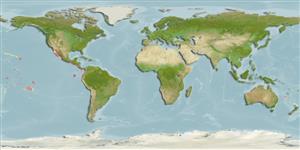Environment: milieu / climate zone / depth range / distribution range
Écologie
marin récifal; profondeur 6 - 61 m (Ref. 5227). Tropical; 32°N -
Eastern Pacific: Gulf of California to Peru, including the Galapagos Islands.
Taille / Poids / Âge
Maturity: Lm ? range ? - ? cm
Max length : 18.0 cm TL mâle / non sexé; (Ref. 9342)
Description synthétique
Clés d'identification | Morphologie | Morphométrie
Épines dorsales (Total) : 10; Rayons mous dorsaux (Total) : 12; Épines anales: 3; Rayons mous anaux: 7.
Inhabits rocky bottoms or isolated reefs (Ref. 9342); usually found near patch reefs on sandy or broken-shell bottoms. Solitary and diurnal. Juveniles under laboratory conditions can tolerate low water temperatures, e.g. 9.4°C (Ref. 6852).
Life cycle and mating behavior
Maturité | Reproduction | Frai | Œufs | Fécondité | Larves
Pelagic spawner.
Heemstra, P.C., 1995. Serranidae. Meros, serranos, guasetas, enjambres, baquetas, indios, loros, gallinas, cabrillas, garropas. p. 1565-1613. In W. Fischer, F. Krupp, W. Schneider, C. Sommer, K.E. Carpenter and V. Niem (eds.) Guia FAO para Identification de Especies para lo Fines de la Pesca. Pacifico Centro-Oriental. 3 Vols. FAO, Rome. (Ref. 9342)
Statut dans la liste rouge de l'IUCN (Ref. 130435: Version 2024-1)
Menace pour l'homme
Harmless
Utilisations par l'homme
Pêcheries: sans intérêt
Outils
Articles particuliers
Télécharger en XML
Sources Internet
Estimates based on models
Preferred temperature (Ref.
123201): 20.3 - 28.8, mean 25.9 °C (based on 74 cells).
Phylogenetic diversity index (Ref.
82804): PD
50 = 0.5000 [Uniqueness, from 0.5 = low to 2.0 = high].
Bayesian length-weight: a=0.01096 (0.00518 - 0.02319), b=3.05 (2.88 - 3.22), in cm total length, based on LWR estimates for this Genus-body shape (Ref.
93245).
Niveau trophique (Ref.
69278): 3.5 ±0.4 se; based on size and trophs of closest relatives
Résilience (Ref.
120179): Milieu, temps minimum de doublement de population : 1,4 à 4,4 années (Preliminary K or Fecundity.).
Fishing Vulnerability (Ref.
59153): Low vulnerability (10 of 100).
Nutrients (Ref.
124155): Calcium = 70 [40, 129] mg/100g; Iron = 0.659 [0.355, 1.097] mg/100g; Protein = 18.4 [16.6, 20.1] %; Omega3 = 0.174 [0.112, 0.269] g/100g; Selenium = 28.6 [16.9, 50.9] μg/100g; VitaminA = 130 [44, 417] μg/100g; Zinc = 1.39 [0.95, 1.96] mg/100g (wet weight);
